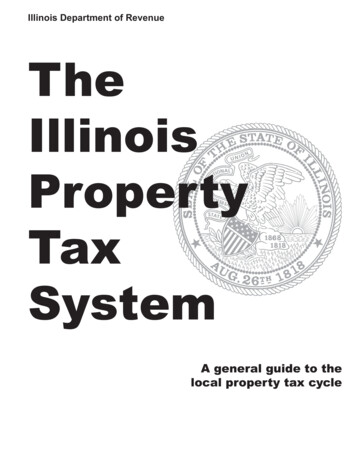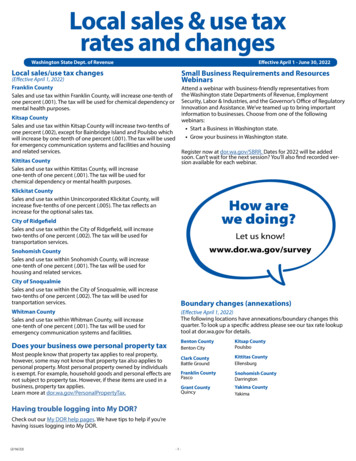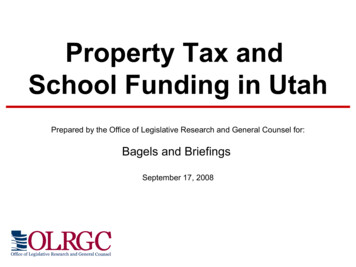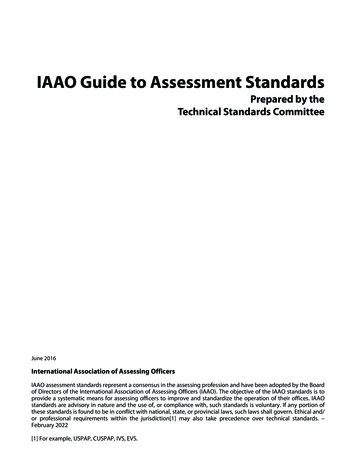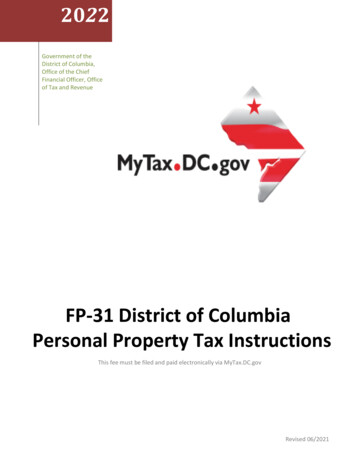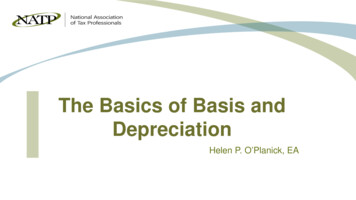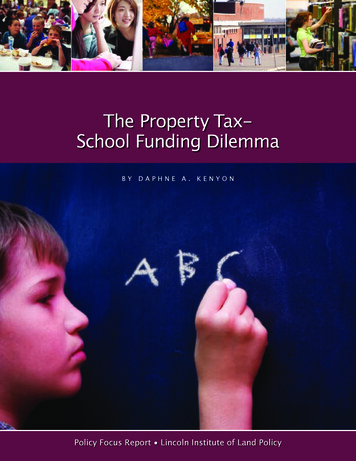
Transcription
The Property TaxSchool Funding DilemmaByDaphneA.KenyonPolicy Focus Report Lincoln Institute of Land Policy
The Property TaxSchool Funding DilemmaThis report is one of a series of policy focus reports published by the Lincoln Institute ofLand Policy to address timely public policy issues relating to land use, land markets, andproperty taxation. Each report is designed to bridge the gap between theory and practice bycombining research findings and case studies with contributions from scholars in a varietyof academic disciplines and from professional practitioners, local officials, and citizens indiverse communities.The Lincoln Institute of Land Policy is a private operating foundation whose mission is toimprove the quality of public debate and decisions in the areas of land policy and land-relatedtaxation in the United States and around the world. The Institute’s goals are to integrate theoryand practice to better shape land policy and to provide a nonpartisan forum for discussion ofthe multidisciplinary forces that influence public policy. The work of the Institute is organized infour departments: Valuation and Taxation, Planning and Urban Form, Economic and CommunityDevelopment, and International Studies. We seek to inform decision making through education,research, demonstration projects, and the dissemination of information through publications,our Web site, and other media. Our programs bring together scholars, practitioners, publicofficials, policy advisers, and involved citizens in a collegial learning environment.Daphne A. Kenyon is principal of D. A. Kenyon & Associates, a public finance consultingfirm in Windham, New Hampshire. She also serves on New Hampshire’s State Board ofEducation and on the Education Commission of the States, a national organization. Prior tofounding her consulting firm, Kenyon served as president of The Josiah Bartlett Center forPublic Policy; professor and chair in the Economics Department at Simmons College; senioreconomist with the Office of Tax Analysis at the U.S. Department of the Treasury, the UrbanInstitute, and the U.S. Advisory Commission on Intergovernmental Relations; and assistantprofessor at Dartmouth College. Kenyon earned her B.A. in economics from Michigan StateUniversity and her M.A. and Ph.D. in economics from the University of Michigan.Kenyon researched and wrote this report while serving as a visiting fellow at the LincolnInstitute of Land Policy. The views expressed in this paper should not be attributed to theLincoln Institute of Land Policy or the New Hampshire State Board of Education.Copyright 2007 by the Lincoln Institute of Land PolicyAll rights reserved.www.lincolninst.eduISBN 978-1-55844-168-2Policy Focus Report / Code PF015
.Contents2Executive Summary4Chapter 1: Understanding the Links Between Property Taxation and School FundingBasic Statistics about K–12 Education and Property TaxesOpposing Views on Local Property Taxes and School Funding LitigationProperty Taxation and School Funding LinksSchool Funding Litigation since the 1960s13 Chapter 2: Case Study StatesIntroduction and Framework for EvaluationCalifornia: The Impetus to Three Decades of State School Funding LitigationNew Jersey: Adoption of an Income Tax and Detailed Judicial MandatesTexas: Decades of Litigation and a New Business TaxMassachusetts: Successful School Finance Restructuring and Property Tax RevoltNew Hampshire: A Statewide Property Tax and Ongoing LitigationOhio: Modest Reforms and Judicial BacktrackingMichigan: School Finance Restructuring Without a Court MandateInsights from the Case Studies32 Chapter 3: Five Property Tax MythsMyth 1: School Funding Litigation–Property Tax LinksMyth 2: Low Property Value Equals Low IncomeMyth 3: Regressivity of the Property TaxMyth 4: Property Tax Rate Equals Property Tax BurdenMyth 5: Demonizing the Property Tax43 Chapter 4: Two School Funding Litigation MythsMyth 6: State Constitutional LanguageMyth 7: Effects of Litigation on Education47 Chapter 5: State Education Aid and Two Related MythsThe Increasing State Role in Funding EducationTypes of General State Aid for SchoolsTargeting General School AidMyth 8: School Aid as Property Tax ReliefMyth 9: Shift to State Funding for Schools52 Chapter 6: ConclusionLessons from the Case Study StatesTwo Policies to AvoidTwo Recommended Policies57 Appendix59 ReferencesK e n y o n T h e p r o p e r t y ta x – S c h o o l F u n d i n g D i l e m m a
.Executive SummaryProperty taxation and school funding are closely linked in the United States, withnearly half of all property tax revenue used for public elementary and secondaryeducation. There is an active policy debate across the country regarding the degreeto which public schools should be funded with property tax dollars. Some policy makersand analysts call for reduced reliance on property taxation and increased reliance on statefunding; others claim that the property tax is a critical ingredient in effective local government.School funding is no less controversial, and nearly every state has dealt with school fundinglitigation over the last 40 years.This report provides an overview ofFIGURE ES-1Share of State and Local Government Taxpolicy issues related to school funding andRevenue from Property Taxes, 2005the property tax, with an emphasis on theproperty tax, through a comprehensive reviewof recent research and case studies of sevenstates—California, Massachusetts, Michigan,New Hampshire, New Jersey, Ohio, and Texas.All these states except California and Ohioare highly reliant on property taxes (see figureES-1). New Hampshire, New Jersey, andTexas are the most reliant on the propertytax, ranking first, second, and third in thenation, respectively.One objective of the report is to provideShare of Tax Revenue from Property Tax 33%information helpful to state policy makersShare of Tax Revenue from Property Tax 25% but 33%and others who are grappling with the twinShare of Tax Revenue from Property Tax 25%challenges of court mandates regarding schoolSource: U.S. Census (2007a).funding and constituent pressure to reduceproperty taxes. Another objective is to correct some common misconceptions regardingschool funding and property taxes through an analysis of nine myths.The consensus among public finance researchers is that property tax relief should betargeted to low- and moderate-income households through a mechanism such as a statefunded property tax circuit breaker program. A growing consensus within the school financecommunity indicates that state aid should be used to improve student outcomes, and thatmore school aid per pupil should be provided to disadvantaged children than to privilegedones. Among the case study states Massachusetts ranks the highest, and California thelowest, according to these respective property tax relief and school funding principles. policy focus report Lincoln Institute of Land Policy
.P r o pert y Ta x – S c h o o l F u n di n g M y t h sMyth 1: School funding litigation reduces reliance on property taxation.Reality: School funding litigation has not significantly reduced reliance on property taxationfor more recent court mandates or for states that replace local property taxation with stateproperty taxation.Myth 2: Property-poor school districts are also low-income districts.Reality: Communities with low per-pupil property values may be high-income communitiesjust as communities with high per-pupil property values can be low-income.Myth 3: The property tax is a regressive tax.Reality: Researchers agree the property tax is not generally regressive, and, to the extent that itis a tax on capital, can be progressive. Furthermore, the property tax is more progressive thanthe sales tax.Myth 4: Property tax rates are a reasonable measure of property tax burden.Reality: Property tax rates are not a good measure of property tax burden because high taxrates can reflect a high level of local government services or restrictive zoning practices rather thanlow fiscal capacity; high tax rates can also reduce house prices, which partially compensates newhomeowners for high taxes.Myth 5: Reducing reliance on property taxation is usually beneficial.Reality: There are advantages to relying on property taxes; they provide stable revenue andpromote local fiscal autonomy and civic engagement, among other virtues.Myth 6: State supreme court school finance rulings rely directly on the language of stateconstitutions.Reality: No direct relationship exists between constitutional language and state supreme courtschool finance rulings; court mandates have differed markedly in two states with nearly identicalconstitutional language.Myth 7: School funding litigation has been a generally effective means of improving educationoutcomes.Reality: Researchers generally find court-mandated school finance restructuring reduces withinstate inequality in education spending per pupil, but they do not find a consistent impact on thelevel of school spending or on student achievement.Myth 8: State aid for schools is one form of property tax relief.Reality: State aid for schools may or may not provide property tax relief, depending uponhow it is structured. State-funded circuit breakers are more likely to achieve that relief.Myth 9: State policy makers should aim to provide more than half of total K–12 funding.Reality: State policy makers should not aim to provide any specific percentage of the total funding for K–12 education. Better policy goals focus on student achievement or limiting propertytax burdens to some percentage of household income.K e n y o n T h e p r o p e r t y ta x – S c h o o l F u n d i n g D i l e m m a
.chapter 1Understanding the LinksBetween Property Taxationand School FundingProperty taxation and school funding are closely linked in the UnitedStates. Independent school districts(those not dependent on city orcountry governments) derive 96 percent oftheir tax revenues from property taxes, thusrelying more heavily on property taxation thanany other type of local government (Fisher2007, 320). At the same time nearly halfof the total property tax dollars collected inthe United States are used to finance publicelementary and secondary education.School funding and property taxation areso interconnected that those who are concerned about school finance find themselvesexamining the role of the property tax, andthose who are interested in property taxationinevitably find they need to consider schoolfinance questions.This report provides an overview of thecritical issues at that intersection, with anemphasis on the role of the property tax.FIGURe 1Distribution of Public K–12 School Revenue, 2004–2005Total: 488.5 billionFederal Sources( 44.5 billion):9.1%LocalProperty Taxes28.7%State Sources( 229.6 ing someproperty taxes)7.6%Other Local Sources7.6%local Sources( 214.5 billion):43.9%B asic S tatisticsab o ut K – 1 2 E ducati o na n d P r o pert y Ta x esFigure 1 shows that in 2004–2005 total U.S.spending on public elementary and secondary education was 488.5 billion, with nearlyhalf (47 percent) of that amount funded bystate sources, slightly less than half (44 percent)funded by local sources, and a modest federalcontribution (9 percent). As a result of the2001 passage of the No Child Left BehindAct, one can expect the federal role in financing of education to grow.Most local funds are derived from taxes,predominantly the property tax. Since 1952,local governments’ reliance on propertytaxes has declined, whether measured asa percentage of local tax revenue, ownsource general revenue, or total generalrevenue (see figure 2). From 1952 to 1982the decline was dramatic, and a period ofrelative stability followed. Local governmentshave received more state aid, increased theirreliance on charges, and in some cases turnedto other tax sources such as income or salestaxes in states that permit local option taxes.Property taxes as a percent of personalincome is the best, but imperfect, measureof property tax burden. Property tax burdenstoday are similar to those of 50 years ago,constituting 3.15 percent of personal income in 2005, only slightly higher than 2.98percent in 1952 (see figure 3). Property taxburdens were highest between 1962 and1972, when property taxes as a percent ofpersonal income hovered around 4 percent.To the extent that property taxes haveshifted between businesses and households,this simple measure may be misleading.Source: U.S. Census (2007b); Tax Foundation (2006). policy focus report Lincoln Institute of Land Policy
.FIGURe 2Local government Property Taxes as a Percent ofVarious Local government Revenue Totals, 98719821977197219520%196710%196220%1957Property Taxes as% of Total Local TaxesProperty Taxes as % of OwnSource General RevenueProperty Taxes as% of Total General Revenue30%Source: Census of Governments (1952–2002), Annual Survey of Government Finances (2005);see Appendix for details.FIGURe 3Local government Property Taxes as aPercent of Personal Income, 2199719921987198219771972196719620%19570.5%1952Opp o si n g V ie w s o n l o calP r o pert y Ta x es a n d S c h o o lF u n di n g L iti g ati o nStrong views on both property taxation andschool finance abound. The boldest statements typically criticize local property taxesin general or their use for financing education. A recent review of policies in the NewEngland states, a region that depends moreheavily on property taxes than the rest ofthe country, is strongly critical of this reliance: “High property taxes—the burdensand perverse incentives they create, the ragethey generate, the town-to-town school funding inequities they proliferate— representan endless New England nightmare ” (Peirceand Johnson 2006). The authors recommendthat New England states restructure theirtax systems by reducing their reliance onproperty taxes and filling the revenue gapby increasing income and sales taxes.A review of school finance by two legalscholars reaches similar conclusions. “Theultimate goal for most states should be reducing reliance on local property tax whileincreasing state funding” (Carr and Griffith2005, 168). The authors recommend thatstate governments should provide at least 60percent of the financial support for publicschools. In 2004–2005 only 12 states metor exceeded this recommended threshold(see chapter 5).On the other side, some scholars conclude that property taxation is an importantrevenue source for effective local government. Wallace Oates (2001, 29) states, “Ifwe acknowledge the need for local taxationin some form to facilitate efficient localdecision-making, the property tax seemsthe right choice, at least in the U.S.” WilliamFischel (2001a, 161) takes a stronger standin favor of the local property tax when hestates, “ there is evidence that loss of localproperty taxation reduces civic engagementgenerally.”Source: Census of Governments (1952–2002), Annual Survey of Government Finances (2005);see Appendix for details.Litigation over school finance is no lesscontroversial. Some groups applaud andadvocate for state school funding lawsuits;others conclude that courts are interferingin legislative decisions and harming publicpolicy. For example, the National AccessNetwork at Columbia University notes thatK e n y o n T h e p r o p e r t y ta x – S c h o o l F u n d i n g D i l e m m a
.in many states adequacy lawsuits “have ledto better education and the stronger communities and economies that result fromgood schools” (ACCESS 2007b). In contrast,economist Eric Hanushek concludes in hisbook, Courting Failure: How School Finance Lawsuits Exploit Judges’ Good Intentions and HarmOur Children, that “ no currently availableevidence shows that past judicial actionsabout school finance—either related toequity or adequacy—have had a beneficial effect on student performance”(Hanushek 2006, xxiii-xxiv).P r o pert y Ta x ati o n a n dS c h o o l F u n di n g L i n ksThe links between property taxation andschool funding are many and varied. Onesuch link starts with a focus on educationneeds, and incorporates the preference forlocal autonomy and local involvement. From this perspective the question is: Whatrevenue source is best suited to supportindependent local governments, includingschool districts? Among the “big three” taxbases of sales, income, and property, property taxation is often seen as the most appropriate source. Local governments face difficulties when they try to tax a mobile taxbase, and the property tax base is generallyless mobile than sales or income.Another rationale for relying on localproperty taxation is the concept of homevoters—voters whose home ownership gives theman incentive to carefully evaluate local schoolspending proposals and support those thatenhance school quality at a reasonable costin terms of taxes (Fischel 2001a).Another key link between the property taxand school funding is the disparity in per-pupilproperty wealth among school districts, andthe possibility that disparities could lead topolicy focus report Lincoln Institute of Land Policy
.inequities for children or taxpayers. For example, children in property-rich districtsmay have access to better education thanchildren in property-poor districts. Alternatively, certain taxpayers may be disadvantaged if property-poor districts require highertax rates than property-rich districts in orderto finance the same quality of education.One can apply a number of definitionsof fairness in restructuring a school fundingsystem. Two definitions in particular—wealthneutrality and access equality—relate directlyto the property tax (see box 1). But just asschool finance lawsuits have shifted their focusover time from disparities in per-pupil property wealth to the needs of school children,so has the equity focus shifted from wealthneutrality and access equality to educationaladequacy.The legislative response to court-imposedschool funding mandates can (but does nothave to) impact the property tax system. Inthe process of restructuring, states can reducereliance on property taxation for fundingschools by increasing state aid, which is oftenfunded through income or sales taxes. Alternatively, states can reduce reliance on localproperty taxes and instead levy a statewideproperty tax at a fixed rate.From a political standpoint, pressure toprovide adequate funding of schools andpressure to provide property tax relief areoften intertwined. State school aid is sometimes mentioned as one source of fundingfor local property tax relief. Taxpayers whowant to see reductions in their propertytax liabilities sometimes press state government for particular school finance restructuring measures. Steven Sheffrin (1998, 133)has observed that “Educational reform mayhave simply served as convenient politicalcover for an underlying desire to shift thetax base away from property and towardother tax bases.”Box 1What Is a Fair School Funding System?State lawmakers restructuring school funding systems face difficulties in part because there are many definitions offairness in school funding. For example, John Yinger (2004, 9) sets out four possible goals of school finance reform: Equality: providing the same education in every school district; Wealth neutrality: providing school aid so that school district wealth and education spending are not correlated,even after local spending behavior changes as a result of that aid; Access equality: ensuring that an increase in the tax rate has the same impact on per-pupil revenue in every district; and Adequacy: affording all students an education that meets some minimum standard.Access equality focuses on fairness to taxpayers, while adequacy focuses on fairness to students. Property tax wealth isa critical element both of wealth neutrality (explicitly) and access equality (implicitly). An adequacy standard focuses on thesituation of the school districts least able to provide some minimum level of education, but does not prevent high-income orwealthy districts from providing superb schools. An equality standard, on the other hand, implies placing a limit on the resourcesthat high-income or wealthy districts may spend on their public education systems. In general over the 40 years of schoolfinance litigation, courts have tended to shift from standards of wealth neutrality or access equality to an adequacy standard.The consensus of some school finance analysts is that “By and large, the attention paid by school finance reformers totaxpayer equity is misguided. With limited fiscal resources in the public sector, we should concentrate our efforts on achievingstudent-based rather than taxpayer-based equity” (Reschovsky 1994, 195).K e n y o n T h e p r o p e r t y ta x – S c h o o l F u n d i n g D i l e m m a
.S c h o o l F u n di n g L iti g ati o nsi n ce t h e 1 9 6 0 sSince the 1960s, equity and adequacyconcerns have prompted lawsuits across thecountry to challenge states’ school fundingsystems. Only five states have not had tocontend with school funding lawsuits (Delaware, Hawaii, Mississippi, Nevada, andUtah). Some lawsuits have resulted inplaintiff victories; others have not.One of the most contentious aspects ofschool funding lawsuits is the appropriateline between judicial and legislative action(see box 2). Legislatures in some states haveresponded to court mandates by restructuring their systems of financing education;others have not. Figure 4 illustrates fivecategories of states with respect to litigationand school finance restructuring (see Appendix for data sources and discussion of thechallenges of classifying states into thesecategories).The courts have been prominent playersin this 50-year drama, so histories of thisissue often focus on changing legal theoriesor strategies, as does the summary below.However, it is important to note that sometimes legislatures have acted to restructureeducation finance and tax structures withoutprodding from the courts, as in the case ofMichigan. (This report is careful to use theterm “restructure” rather than “reform”to describe large-scale changes in schoolfinance systems because the term “reform”carries a positive connotation that is notalways warranted.)Early Need-Based LawsuitsWere Unsuccessful (1960s)The initial focus of school funding lawsuitswas educational opportunity for disadvantaged children. Some authors trace the rootsof school finance litigation to Brown v. Boardof Education of Topeka (1954) in which “separate but equal” schools were found to violatethe equal protection clause of the UnitedBox 2School Funding Lawsuits and Separation of Powers“As school finance legislation grinds on the line between the legislature and the judiciary frequently becomes almostindistinct, with the legislature accusing the judiciary of encroaching on its turf and the judiciary accusing the legislatureof failing to fulfill its constitutional duty to properly fund schools” (Carr and Griffith 2005).The separation of judicial, executive, and legislative powers is a basic part of our American system of government. JamesMadison argued in The Federalist Papers that the separation of powers was essential for preserving the liberty of citizens.Notwithstanding this national premise, states have reached very different decisions regarding the appropriate roles oflegislatures versus the courts in the realm of K–12 education.In some states courts have rejected school funding lawsuits either because they did not view education as a fundamentalright or because they accepted that it was the legislature’s responsibility to make policy judgments about public education.For example, when Massachusetts’ highest court removed itself from the school funding process, it noted, “Because decisions about where scarce public money will do the most good are laden with value judgments, those decisions are bestleft to our elected representatives” (Hancock v. Driscoll 2005).Other state courts have made very specific policy judgments, including the dollar amount of K–12 spending (Kansas),the form of the school aid formula (New Hampshire), permissible tax structure for funding education (New Hampshire andTexas), and required curriculum (New Jersey). policy focus report Lincoln Institute of Land Policy
.FIGURE 4School Finance Restructuring by StateStates Constitution because they discriminated among individuals on the basis of race(McDonald, Kaplow, and Chapman 2006;Odden and Picus 2000; Starr 2007). In BrownChief Justice Earl Warren emphasized thecritical importance of public education:Today, education is perhaps the mostimportant function of state and localgovernments In these days, it is doubtful that any child may reasonably beexpected to succeed in life if deniedthe opportunity of an education.Many school finance cases also reston equal protection claims, but instead offocusing on race, as Brown did, they havefocused on economic status.The first lawsuits challenging schoolfinance systems occurred in the late 1960s.In McInnis v. Shapiro (1968), an Illinois case,the plaintiffs charged that the state failed todistribute education aid based on the educational needs of the districts. Burrus v. Wilkerson(1969) was a similar Virginia suit, also filedin federal court. In each case the federalcourt rejected the claims “on the groundthat it could not discern judicially manageable standards to gauge what students’ needswere and whether they were being met”(Minorini and Sugarman 1999, 37). Litigantsappealed both cases to the United StatesSupreme Court, which affirmed lower courtrulings. The failure of these early cases ledlawyers concerned with school finance equityto seek a new approach to litigation.Equitable Finance of EducationSought in Federal and State Courts(Late 1960s to 1973)This second wave of more successful schoolfunding lawsuits was based on the theory thatschool spending per pupil should not dependon the school district’s property wealth. Evidence was put forward comparing schooldistricts with low property wealth, high taxSubject to a highest court mandate that promptedschool finance restructuringSubject to a highest court mandate that did notprompt school finance restructuringRestructuring without a highest court mandateNo court mandate and no school finance restructuringNo school finance litigation and no restructuringSource: Author calculations based on ACCESS (2007a), Sielke et al. (2001),and various state government Web sites; see Appendix for details.Table 1Comparison of Selected California School Districts, 1968–1969Pupils(#)AssessedValue per PupilTax RateExpenditureper PupilBeverly Hills5,542 50,885 2.38/ 1,000 1,232Baldwin Park13,108 3,706 5.48/ 1,000 577Source: Serrano v. Priest (1971) as quoted in Odden and Picus (2000, 12).rates and low per pupil spending to otherschool districts with high property wealth,low tax rates, and high per pupil spending.Plaintiffs compared a pair of school districtsin Los Angeles County: Beverly Hills, anaffluent district with high assessed value perpupil, a low tax rate, and high per pupilspending; and Baldwin Park, a poor districtwith low assessed value per pupil, a high taxrate and low per pupil spending (see table 1).Of course, not all school districts across thecountry fit this pattern (Odden and Picus2000, 22).K e n y o n T h e p r o p e r t y ta x – S c h o o l F u n d i n g D i l e m m a
.From the late 1960s until 1973, lawsuitschallenging state school funding systems onequal protection grounds were brought inboth state and federal courts. The mostsignificant decision of this era was California’s Serrano v. Priest (1971), in which theCalifornia Supreme Court found that thestate’s school funding system violated theequal protection clauses of both the federaland California constitutions.The most significant defeat of this era(for supporters of school funding lawsuits)was the United States Supreme Court’s 1973decision in San Antonio Independent School Districtv. Rodriguez. In that case the court decidedschool funding disparities in Texas did notviolate the equal protection clause of theUnited States Constitution. In a 5–4 decision, the court held that education was nota fundamental right and property wealthper pupil was not a suspect class.Rodriguez effectively shut the door onfederal school funding lawsuits. From 1973on, those working to obtain equitable schoolfunding through litigation shifted theirefforts to state courts.Equitable Finance of EducationSought in State Courts (1973 to 1989)This period of school finance litigation alsorested on equal protection claims, but understate constitutions. The Rodriguez ruling didnot overturn Serrano v. Priest because it wasalso based on a state constitution. Moreover,the California court reaffirmed its findingon the basis of the state’s constitution inSerrano II (1976).This wave of school finance litigation continued to focus on interdistrict disparities inproperty tax bases and the resulting inequalities in per pupil school spending, but theratio of plaintiff victories to lawsuits filedwas low. Beginning in 1989, plaintiffs shiftedto a different approach that enabled them tooverturn more states’ school funding systems.10Adequate Education Sought inState Courts (since 1989)With the 1989 Rose v. Council for Better Education, Inc. decision in Kentucky, school financesuits moved to a focus on adequacy and toclaims arising from education clauses instate constitutions. One typical state constitution education clause found in both NewHampshire and Massachusetts requires thestate legislature to “cherish” education. Underthe adequacy theory, the focus shifted to theclaim that state government must assure thatall chil
funding; others claim that the property tax is a critical ingredient in effective local government. School funding is no less controversial, and nearly every state has dealt with school funding litigation over the last 40 years. This report provides an overview of policy issues related to school funding and


